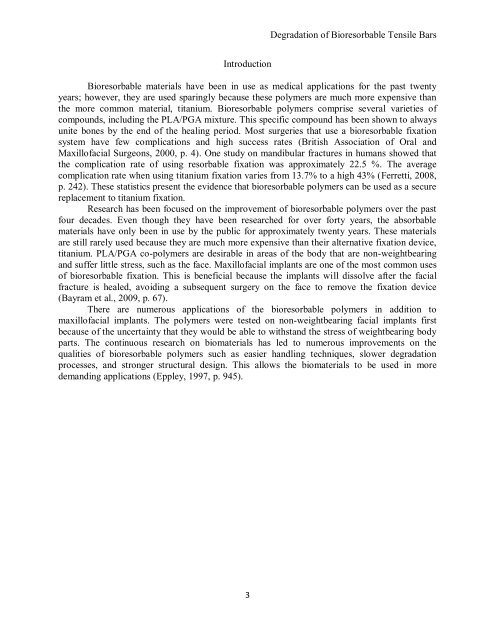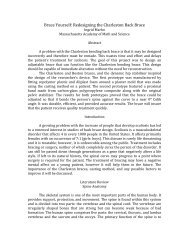A Study of Tensile Degradation of Bioresorbable Materials Used for ...
A Study of Tensile Degradation of Bioresorbable Materials Used for ...
A Study of Tensile Degradation of Bioresorbable Materials Used for ...
You also want an ePaper? Increase the reach of your titles
YUMPU automatically turns print PDFs into web optimized ePapers that Google loves.
<strong>Degradation</strong> <strong>of</strong> <strong>Bioresorbable</strong> <strong>Tensile</strong> Bars<br />
Introduction<br />
<strong>Bioresorbable</strong> materials have been in use as medical applications <strong>for</strong> the past twenty<br />
years; however, they are used sparingly because these polymers are much more expensive than<br />
the more common material, titanium. <strong>Bioresorbable</strong> polymers comprise several varieties <strong>of</strong><br />
compounds, including the PLA/PGA mixture. This specific compound has been shown to always<br />
unite bones by the end <strong>of</strong> the healing period. Most surgeries that use a bioresorbable fixation<br />
system have few complications and high success rates (British Association <strong>of</strong> Oral and<br />
Maxill<strong>of</strong>acial Surgeons, 2000, p. 4). One study on mandibular fractures in humans showed that<br />
the complication rate <strong>of</strong> using resorbable fixation was approximately 22.5 %. The average<br />
complication rate when using titanium fixation varies from 13.7% to a high 43% (Ferretti, 2008,<br />
p. 242). These statistics present the evidence that bioresorbable polymers can be used as a secure<br />
replacement to titanium fixation.<br />
Research has been focused on the improvement <strong>of</strong> bioresorbable polymers over the past<br />
four decades. Even though they have been researched <strong>for</strong> over <strong>for</strong>ty years, the absorbable<br />
materials have only been in use by the public <strong>for</strong> approximately twenty years. These materials<br />
are still rarely used because they are much more expensive than their alternative fixation device,<br />
titanium. PLA/PGA co-polymers are desirable in areas <strong>of</strong> the body that are non-weightbearing<br />
and suffer little stress, such as the face. Maxill<strong>of</strong>acial implants are one <strong>of</strong> the most common uses<br />
<strong>of</strong> bioresorbable fixation. This is beneficial because the implants will dissolve after the facial<br />
fracture is healed, avoiding a subsequent surgery on the face to remove the fixation device<br />
(Bayram et al., 2009, p. 67).<br />
There are numerous applications <strong>of</strong> the bioresorbable polymers in addition to<br />
maxill<strong>of</strong>acial implants. The polymers were tested on non-weightbearing facial implants first<br />
because <strong>of</strong> the uncertainty that they would be able to withstand the stress <strong>of</strong> weightbearing body<br />
parts. The continuous research on biomaterials has led to numerous improvements on the<br />
qualities <strong>of</strong> bioresorbable polymers such as easier handling techniques, slower degradation<br />
processes, and stronger structural design. This allows the biomaterials to be used in more<br />
demanding applications (Eppley, 1997, p. 945).<br />
3
















